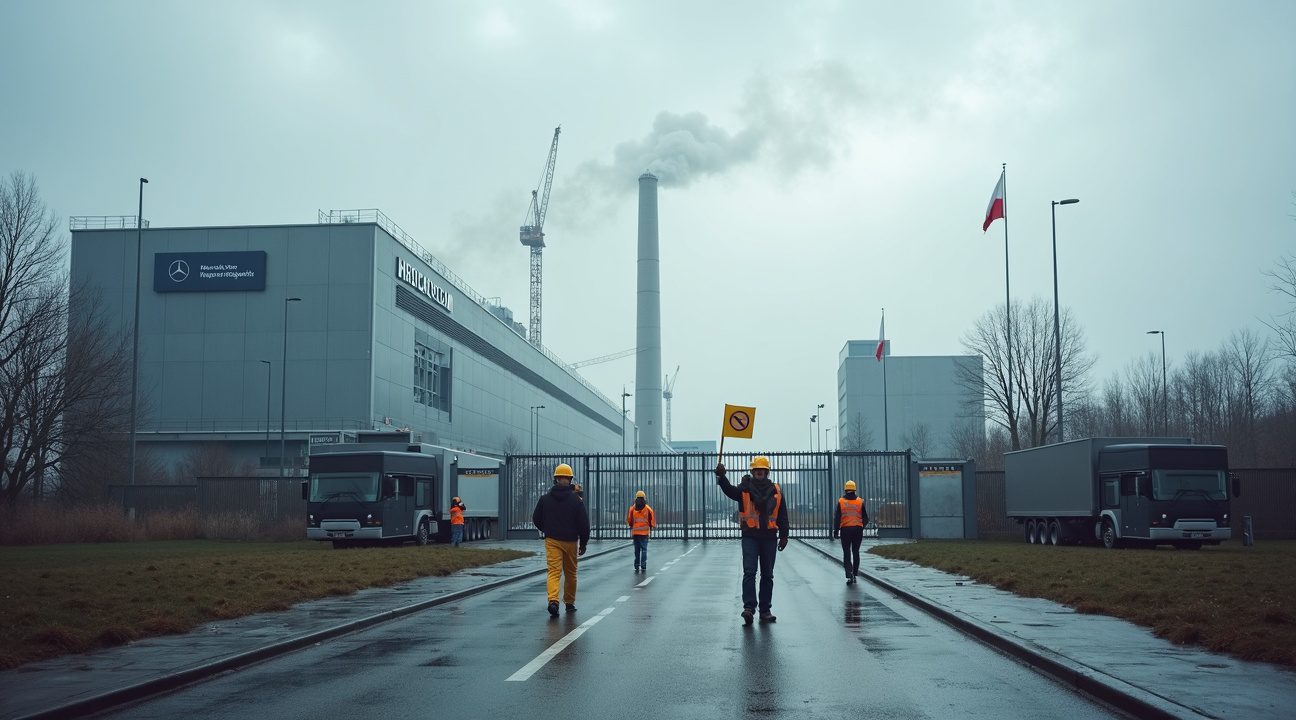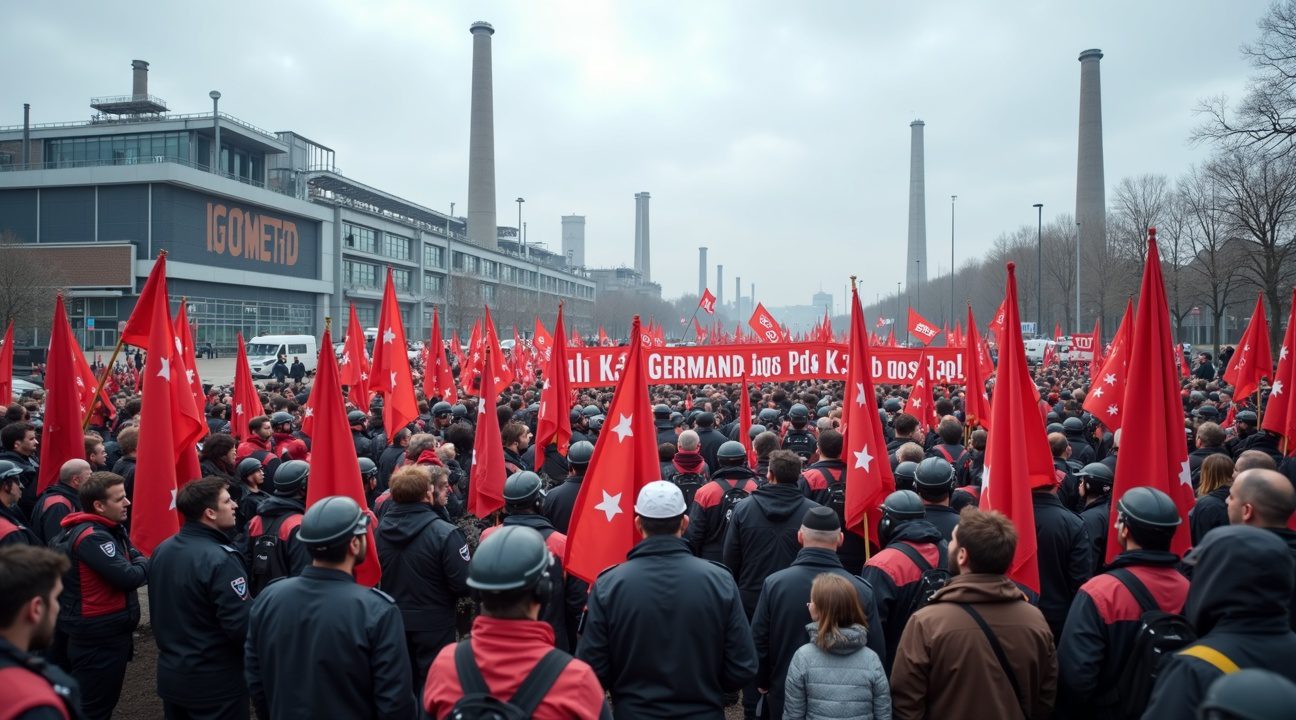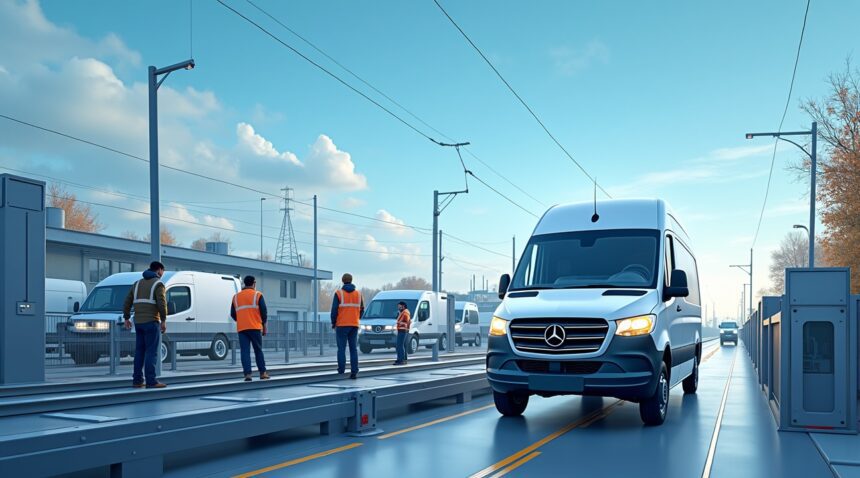Mercedes-Benz has announced plans to close its Ludwigsfelde manufacturing plant near Berlin by 2029, marking the end of over 30 years of operations, as production shifts to Poland.
Key Takeaways
- Mercedes-Benz will invest €360 million to expand its facility in Jawor, Poland, by 2027, adding 300 new jobs. This contrasts sharply with the loss of over 2,200 positions at the Ludwigsfelde plant in Germany.
- The move centers on Sprinter van production, including both traditional combustion-engine and electric e-Sprinter models, as part of the company’s broader push into electric commercial vehicles.
- Lower labor costs are a key driver of the decision. Manufacturing expenses in Germany are estimated at five times the cost of those in Poland, prompting strategic shifts amid global competition.
- German trade unions, including IG Metall, are actively protesting the plant closure. They argue the move threatens job security and sets a dangerous precedent for other manufacturers considering similar relocations.
- The transition also reflects a larger industry trend of Western European automakers migrating production to Central and Eastern Europe, where firms benefit from lower costs, educated workforces, and developed infrastructure.
More details on this story can be found on the Reuters report covering Mercedes-Benz’s strategic relocation.
Mercedes Shuts Down 30-Year-Old German Plant, Moves 60,000 Annual Vehicle Production to Poland
Mercedes-Benz has announced the closure of its Ludwigsfelde manufacturing plant near Berlin by the end of 2029, marking the end of over three decades of German production at this facility. The automotive giant plans to relocate its entire production capacity to Jawor in southwestern Poland, affecting more than 2,200 employees and an annual output of approximately 60,000 vehicles.
Production Shift Focuses on Sprinter Van Portfolio
The Ludwigsfelde plant specializes in manufacturing Mercedes-Benz Sprinter vans, including both traditional combustion engine variants and the electric e-Sprinter models. These commercial vehicles have established themselves as crucial components of Mercedes-Benz’s commercial vehicle strategy, serving businesses across Europe and beyond. Production of these specialized vehicles will transition entirely to the Polish facility, where Mercedes-Benz expects to maintain and potentially expand current manufacturing capabilities.
This strategic relocation represents more than a simple geographic shift. Mercedes-Benz views the Polish facility as central to expanding its electric commercial vehicle ambitions, with the e-Sprinter becoming a flagship product for the new location. The electric variant addresses growing demand for sustainable commercial transportation solutions, particularly as European regulations increasingly favor zero-emission vehicles in urban logistics operations.
Economic Factors Drive Strategic Relocation
Several factors contribute to Mercedes-Benz’s decision to relocate production from Germany to Poland. Manufacturing costs in Poland remain significantly lower than in Germany, including labor expenses, facility operations, and regulatory compliance costs. The company can achieve greater operational efficiency while maintaining production quality standards that Mercedes-Benz customers expect.
The Jawor facility offers strategic advantages for commercial vehicle production, including:
- Modern manufacturing infrastructure that supports both traditional and electric vehicle assembly
- Proximity to key European markets while reducing overall production costs
- Access to skilled workforce with automotive manufacturing experience
- Government incentives supporting automotive industry development
- Enhanced supply chain efficiency for component sourcing
Poland’s automotive sector has experienced substantial growth over recent years, attracting major manufacturers seeking competitive production environments. Mercedes-Benz joins other German automakers who have successfully established operations in Poland, benefiting from the country’s strategic location within the European Union and its commitment to automotive excellence.
The transition timeline extends through 2029, allowing Mercedes-Benz to manage the shift systematically while minimizing disruption to current customers and supply chains. This measured approach ensures that Sprinter van production continues meeting market demand throughout the relocation process. The company hasn’t disclosed specific plans for the 2,200 affected employees, though industry observers expect Mercedes-Benz to offer relocation opportunities and retraining programs where feasible.
Electric vehicle production represents a particularly strategic element of this move. The e-Sprinter’s centrality to the Polish facility reflects Mercedes-Benz’s broader commitment to electrifying its commercial vehicle lineup. European markets increasingly demand electric commercial vehicles as cities implement stricter emission regulations and businesses seek sustainable transportation solutions.
The Ludwigsfelde plant’s closure symbolizes broader changes within the European automotive industry, where manufacturers continuously evaluate production strategies against evolving market conditions. Cost optimization, regulatory compliance, and technological advancement drive these decisions, often requiring difficult choices about traditional manufacturing locations.
This production shift demonstrates how even established automotive operations must adapt to remain competitive. While the closure affects local employment and regional economics around Berlin, Mercedes-Benz’s investment in Polish manufacturing capabilities signals confidence in Central European automotive production potential. The move positions the company to serve European markets more efficiently while advancing its electric vehicle strategic objectives through specialized production facilities optimized for next-generation commercial vehicles.
Labor Costs Five Times Higher Drive Strategic Relocation Decision
Mercedes-Benz faces mounting pressure to reduce operational expenses as global competition intensifies, particularly from Chinese automakers who’ve dramatically accelerated their electric vehicle production capabilities. The stark disparity in labor costs between Germany and Poland represents a compelling financial incentive that’s difficult to ignore.
The Financial Reality Behind the Move
Labor costs in Germany currently run approximately five times higher than those in Poland, creating substantial overhead burdens for automotive manufacturers. I’ve observed this cost differential forcing numerous European companies to reconsider their production strategies, especially as profit margins tighten across the automotive sector. Mercedes recognizes that maintaining competitiveness requires aggressive cost optimization measures, particularly when Chinese manufacturers continue to undercut traditional European pricing structures.
Operating expenses extend beyond simple wage disparities. Germany’s comprehensive social security systems, mandatory benefits packages, and strict labor regulations contribute to elevated production costs that directly impact bottom-line performance. Polish manufacturing facilities offer similar skilled workforce capabilities while maintaining significantly lower operational overhead, making relocation an attractive strategic option.
Strategic Positioning in Europe’s EV Battery Hub
Poland’s emergence as the world’s second-largest producer of electric vehicle batteries after China adds considerable strategic value to this relocation decision. This positioning provides Mercedes with direct access to critical supply chain components while reducing transportation costs and delivery timeframes. The proximity to battery production facilities aligns perfectly with Mercedes’ electric vehicle expansion plans.
The country’s growing automotive ecosystem includes major suppliers and component manufacturers who’ve already established operations there. This concentration creates synergistic benefits that extend beyond labor cost savings. I believe Mercedes can leverage these existing relationships to streamline production processes and accelerate time-to-market for new electric models.
Polish government incentives for automotive manufacturing further enhance the economic attractiveness of this move. Tax advantages, infrastructure investments, and streamlined regulatory processes create an environment that supports rapid scaling of production capabilities. These factors combine to offer Mercedes a comprehensive cost advantage that addresses multiple operational challenges simultaneously.
The relocation strategy reflects broader industry trends where traditional automotive powerhouses must adapt to changing economic realities. Chinese competitors continue gaining market share through aggressive pricing strategies enabled by lower production costs. Mercedes’ decision demonstrates proactive management of cost structures while positioning the company closer to essential supply chain partners in the electric vehicle ecosystem.
This move represents more than cost cutting—it’s strategic repositioning for the electric vehicle transition. Poland’s established battery production infrastructure provides Mercedes with competitive advantages that German facilities simply cannot match at current cost levels.
Over 2,200 German Jobs at Risk as Mercedes Invests €360 Million in Polish Expansion
Mercedes-Benz’s decision to relocate production from its Ludwigsfelde facility near Berlin to Poland represents one of the most significant automotive industry restructurings in recent years. The German automaker plans to invest PLN 1.528 billion (approximately €360 million) in expanding its existing Jawor facility, creating a stark contrast between growth opportunities in Poland and job losses in Germany.
The investment will generate at least 300 new positions at the Polish facility by 2027, with 30 of these roles specifically designated for specialists holding higher education qualifications. This selective hiring approach reflects Mercedes-Benz’s strategy to establish a highly skilled workforce capable of handling advanced manufacturing processes. The expansion in Jawor demonstrates the company’s confidence in Poland’s automotive manufacturing capabilities and its skilled labor force.
German Workers Face Uncertain Future
The closure of the Ludwigsfelde plant puts more than 2,200 German jobs in jeopardy, creating significant anxiety among workers and their families. Local officials and labor activists have made this situation a central focus of their advocacy efforts, recognizing the substantial social and economic consequences for the region. The plant closure represents more than just job losses—it signals a potential erosion of Germany’s automotive manufacturing base.
Regional economic impacts extend beyond the immediate workforce, affecting local suppliers, service providers, and retail businesses that depend on the purchasing power of Mercedes employees. Communities surrounding the Berlin facility face the prospect of reduced tax revenues and decreased economic activity. Labor unions have expressed concerns about the precedent this sets for other international manufacturers operating in Germany.
Mercedes-Benz’s decision aligns with a broader industry trend of Western European automakers seeking cost advantages and improved supply chain efficiency in Central and Eastern Europe. Companies across the automotive sector have discovered that relocating production to countries like Poland, Czech Republic, and Slovakia offers significant operational benefits while maintaining quality standards.
Poland’s automotive sector has experienced remarkable growth, attracting major manufacturers with competitive labor costs, government incentives, and strategic location within the European Union. The country’s membership in the EU eliminates trade barriers while providing access to skilled workers at lower wage levels than traditional Western European manufacturing centers. Supply chain considerations also favor Polish locations, with proximity to component suppliers and efficient transportation networks.
The Mercedes investment reflects Poland’s emergence as a serious competitor in the global automotive manufacturing landscape. Government policies supporting foreign investment, combined with educational institutions producing qualified technical graduates, have created an attractive environment for multinational corporations. Tesla’s partnership developments with various international companies illustrate how automotive manufacturers increasingly seek strategic advantages through geographic diversification.
Mercedes-Benz faces the challenge of managing this transition while maintaining production quality and minimizing disruption to its supply chains. The company must ensure that the Polish facility can meet the same stringent standards that German operations have maintained for decades. Training programs and technology transfers will play crucial roles in establishing operational excellence at the expanded Jawor plant.
German economic policymakers are closely monitoring this situation, recognizing that Mercedes-Benz’s decision could influence other manufacturers’ location strategies. The loss of automotive jobs in traditional manufacturing regions raises questions about Germany’s long-term competitiveness in industries where labor costs represent significant operational expenses.
The automotive industry’s shift eastward reflects broader economic realities affecting manufacturing across Europe. Companies must balance stakeholder interests while pursuing strategies that ensure long-term viability in increasingly competitive global markets. Mercedes-Benz’s investment in Poland represents a calculated decision based on economic fundamentals rather than any dissatisfaction with German operations or workforce quality.
This restructuring highlights the ongoing challenges facing established manufacturing regions as they compete with emerging centers offering different value propositions. The success of Poland’s automotive sector demonstrates how strategic government policies and workforce development can attract major international investments, while simultaneously illustrating the difficult choices companies face when optimizing their global operations.

German Trade Unions Launch Protests Against Production Shift
IG Metall Leads Opposition Movement
I’ve observed that IG Metall, Germany’s powerful industrial union, has positioned itself at the forefront of resistance against Mercedes’ planned production relocation. The union has announced a series of protests aimed at pressuring the automaker to reconsider its decision to transfer manufacturing operations from Berlin to Poland. IG Metall officials have characterized the move as a direct assault on German workers’ livelihoods and a betrayal of the country’s strong industrial heritage.
The union’s criticism extends beyond immediate job concerns. Representatives argue that such relocations represent a troubling trend that undermines Germany’s position as a manufacturing powerhouse. They’ve expressed particular frustration with what they perceive as corporate prioritization of short-term cost savings over long-term investment in German workforce development and technological advancement.
Regional Political and Economic Concerns
Local authorities in Ludwigsfelde haven’t remained silent on this issue. Municipal leaders have voiced serious concerns about the economic ripple effects that Mercedes’ departure could trigger throughout the region. I’ve noted that these officials worry about the loss of high-paying manufacturing jobs and the potential domino effect on local suppliers and service businesses that depend on the automotive facility.
Regional politicians have amplified these concerns, pointing to several key issues that the production shift could create:
- Unemployment spikes in an area heavily dependent on automotive manufacturing
- Reduced tax revenue for local municipalities affecting public services
- Loss of technical expertise and skilled workers who may relocate or leave the industry
- Negative impact on supplier networks and ancillary businesses
- Potential closure of training facilities and apprenticeship programs
The political response has been swift and coordinated. State-level representatives have called for emergency meetings with Mercedes executives to discuss alternatives to the relocation plan. Some have even suggested potential policy interventions to make German production more competitive, though specific details remain under discussion.
I’ve noticed that the opposition movement has gained momentum as local business leaders and community organizations have joined the protests. The collective response reflects deeper anxieties about Germany’s industrial competitiveness in an increasingly global marketplace. Many stakeholders view this particular case as emblematic of broader challenges facing German manufacturing, including high labor costs, regulatory complexity, and energy expenses.
The situation has created an interesting parallel to other recent corporate decisions that have sparked similar debates. Just as entertainment industry developments like major entertainment announcements can capture public attention, this industrial shift has become a focal point for discussions about economic policy and worker rights in Germany.
Trade union representatives have emphasized that their opposition isn’t merely about preserving existing jobs, but about maintaining Germany’s reputation as a center for high-quality automotive manufacturing. They argue that relocating production to lower-cost countries may provide immediate financial benefits but could damage the Mercedes brand’s association with German engineering excellence.
The protest movement has also highlighted concerns about the precedent this relocation might set for other automotive manufacturers operating in Germany. Union leaders worry that if Mercedes successfully implements this shift without significant resistance, other companies might follow suit, potentially accelerating the erosion of Germany’s automotive manufacturing base.
Local suppliers have expressed particular anxiety about their future prospects. Many smaller companies have invested heavily in specialized equipment and processes specifically designed to serve Mercedes’ Berlin operations. The potential loss of this major customer could force these businesses to undergo costly restructuring or face closure entirely.
The timing of these protests coincides with broader discussions about European industrial policy and competitiveness. Government officials at various levels are grappling with how to balance support for business flexibility with protection of domestic manufacturing capabilities and employment.

Poland’s Growing EV Manufacturing Hub Attracts Major Automakers
Mercedes’ decision to relocate production from Berlin to Poland reflects a broader transformation sweeping across the automotive industry. The German automaker has chosen to expand operations at its existing Jawor facility, a location that has already proven its value in advanced manufacturing since 2019.
Strategic Foundation Already in Place
The Jawor facility offers Mercedes a significant advantage with its established infrastructure. The plant currently manufactures engines and hybrid vehicle batteries, creating a solid foundation for expanding into electric delivery van production. This existing expertise in battery technology positions the facility perfectly for the transition to full electric vehicle manufacturing.
Several factors make Poland particularly attractive for EV production expansion:
- Lower labor costs compared to traditional German manufacturing centers
- Growing technical expertise in electric vehicle battery manufacturing
- Established supply chain networks for automotive components
- Government incentives supporting green technology investments
- Strategic geographic location for European market distribution
Labor cost advantages play a crucial role in Mercedes’ strategic planning. Polish manufacturing wages remain significantly lower than German equivalents while maintaining high skill levels and quality standards. This cost differential becomes even more important as automakers face pressure to make electric vehicles more affordable for mainstream consumers.
Poland’s rapid development of EV battery manufacturing expertise creates additional value for Mercedes. The country has invested heavily in training programs and technology transfer initiatives that have built a workforce capable of handling sophisticated electric vehicle components. This technical foundation allows manufacturers to scale operations quickly without the typical learning curve associated with new technology adoption.
The shift aligns with industry-wide trends that see major automakers restructuring their European operations. Volkswagen has significantly increased its Central and Eastern European manufacturing footprint, recognizing the region’s potential for cost-effective production. Similarly, Stellantis has expanded operations in countries like Poland and Hungary as part of its strategy to maintain competitive pricing in the electric vehicle market.
Geographic advantages also factor into Poland’s appeal. The country’s central location provides efficient access to both Western European markets and emerging Eastern European demand. Transportation costs and delivery times benefit from this strategic positioning, particularly important for commercial vehicles like delivery vans where total cost of ownership matters significantly to fleet operators.
Government support for green technology initiatives adds another layer of attraction. Polish authorities have implemented various incentive programs designed to attract EV manufacturing investments. These policies create a favorable business environment that reduces operational costs and accelerates project timelines for companies like Mercedes.
The automotive industry’s transformation requires manufacturers to balance quality, cost, and speed of production. Poland’s combination of skilled workforce, lower operational costs, and supportive regulatory environment creates an ideal scenario for achieving these goals. Mercedes’ decision demonstrates how established automakers are adapting their global manufacturing strategies to remain competitive in the electric vehicle era.
This trend extends beyond individual company decisions to represent a fundamental shift in European automotive manufacturing. Traditional manufacturing centers in Germany and France face increasing pressure to maintain competitiveness while Central and Eastern European countries offer compelling alternatives that don’t compromise on quality or technical capability.
The success of Mercedes’ Polish operations will likely influence other automakers considering similar moves. As the electric vehicle market continues expanding, manufacturers need production facilities that can scale efficiently while maintaining the high standards consumers expect from premium brands. Poland’s growing reputation as an EV manufacturing hub positions it well to attract additional investments from major automotive companies seeking to optimize their European production networks.
https://www.youtube.com/watch?v=7p0ZAF-RTao
Western European Automakers Follow Broader Manufacturing Migration Pattern
Mercedes-Benz’s decision to relocate production from Berlin to Poland represents just one example of a significant industry-wide transformation. Western European automakers have increasingly recognized the strategic advantages offered by Central and Eastern European manufacturing hubs, creating a migration pattern that’s reshaping the continent’s automotive landscape.
Volkswagen has substantially expanded its Central European operations, while Stellantis continues to increase manufacturing capacity across the region. These moves demonstrate how established automakers are adapting to economic pressures while maintaining their competitive edge in an increasingly challenging market environment.
Strategic Advantages Driving the Shift
Several key factors make Central and Eastern Europe attractive for automotive manufacturing:
- Lower labor costs compared to traditional Western European manufacturing centers
- Modern infrastructure and skilled workforce availability
- Favorable government incentives and regulatory environments
- Proximity to major European markets while maintaining cost efficiency
- Established supplier networks that support automotive production
The automotive industry faces unprecedented challenges as it transitions to electric vehicles. Manufacturers must balance massive investments in new technology with the need to maintain profitable operations. Moving production to regions with more favorable cost structures allows companies to allocate resources more effectively during this critical transition period.
Traditional manufacturing expertise developed over decades in Western Europe isn’t disappearing. Instead, companies are leveraging this knowledge while taking advantage of more competitive operational costs. Engineering centers and research facilities often remain in established locations, while manufacturing operations migrate to areas where production economics make more sense.
Central and Eastern European countries have invested heavily in automotive infrastructure over the past two decades. Poland, in particular, has emerged as a major automotive manufacturing hub, hosting production facilities for numerous international brands. The country’s strategic location provides excellent access to both Western and Eastern European markets.
This geographic shift reflects broader economic realities facing the automotive sector. Electric vehicle development requires substantial capital investment, and manufacturers must find ways to reduce costs in other areas to fund this transformation. Production relocation offers one pathway to achieve these financial objectives while maintaining product quality and market competitiveness.
Supply chain considerations also play a crucial role in these decisions. Central European locations often provide better access to critical components and materials, reducing transportation costs and improving delivery times. As automakers work to optimize their operations for the electric vehicle era, these logistical advantages become increasingly important.
The trend shows no signs of slowing as manufacturers continue evaluating their global footprints. Companies that successfully adapt their production strategies while maintaining their technological leadership will be better positioned to thrive in the evolving automotive landscape.
Sources:
Elledgy Magazine: “Mercedes is preparing to move some of its production from Germany to Poland”
Anadolu Agency: “Mercedes plans to move jobs to Poland due to high labor costs in Germany”
DSF.my: “Mercedes-Benz Shifts e-Sprinter Production To Poland”
Warsaw Tribune: “Mercedes-Benz Set to Relocate Van Production to Poland”
TVP World/@tvp_world: “Mercedes-Benz plans to relocate part of its vehicle production from Berlin to Poland”


